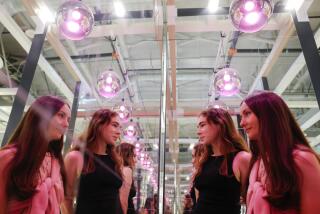Virality erupts at IKEA in Burbank
- Share via
For reasons known only to the pop-culture gods, IKEA -- the Swedish retailer of cheap, lingonberry-flavored furniture and other shinola -- has suddenly become a ubiquitous presence in the ether. Example: in August, when the 2010 IKEA catalog came out, people went utterly bonkers because the designers had changed the print font from the familiar Futura to Verdana -- an esoteric difference, to be sure. The story rocketed to No. 2 on CNN.com’s most-read list, according to Mona Astra Liss, IKEA’s director of public relations. But for the passing of Sen. Edward M. Kennedy, the story might have gone to No. 1.
My colleague David Pierson’s story about Chinese customers flaking out at the Beijing IKEA store -- even taking naps on the beds -- camped at the No. 1 spot on the Los Angeles Times website for two days last month.
What’s your zeitgeist-y preoccupation? Terrorism? A couple of Scottish kids on trial this week allegedly considered taking out the local IKEA with a Columbine-style attack. Environmentalism? Ellen Ruppel Shell’s new book, “Cheap: The High Cost of Discount Culture,” slags supposedly enviro-friendly IKEA for supporting a throwaway materialism and encouraging the destruction of Chinese and Russian forests.
Good, bad or indifferent, the company scored a staggering 1 billion impressions -- the number of people who saw the IKEA brand -- in the fiscal year ended Sept. 1, Liss says.
It seems wherever you look, like Tom Joad, IKEA will be there.
Ground zero of IKEA’s mind share is, strangely enough, the Burbank store. No less than three popular Web videos and one rather large motion picture have been shot there in the last three years. In the film “(500) Days of Summer,” Tom and Summer romp through the Burbank store, playing house amid the store dioramas of modern kitchens and bedroom furniture.
The Burbank store also furnished the backdrop for last year’s IKEA-funded Web TV series “Easy to Assemble,” which followed actress Illeana Douglas as she struggled to adapt to the life of a schlub in blue-and-gold polo shirt . . . I mean, an IKEA team member.
“Easy to Assemble,” which got picked by CBS for its www.tv.com outlet, was a fairly radical bit of marketing. It was stone-cold branded entertainment -- the IKEA logo is in every shot. Yet IKEA also gave Douglas and her collaborators room to gently mock it, right down to the tiny pencils.
“The nature of our brand is very playful,” Liss says.
That playfulness, however, is being tested. In 2006, Web auteur Sean Sahlin surreptitiously shot a parody of MTV’s “The Real World” inside the Burbank store. “The Real World: IKEA” ends with the five cast members bickering and screaming obscenities at one another in a classic “Real World” dust-up. As the IKEA staff pushes through a crowd of horrified customers to break up the disturbance, one cast member takes off his clothes. The Burbank cops are called. Everybody runs for the doors.
“The Real World: IKEA” sums up the dilemma marketers face when users -- on Twitter, Facebook, YouTube, wherever -- take it upon themselves to offer their own valentines to their brands. Obviously, IKEA doesn’t want to sanction disorder in the Burbank store. But how can it walk away from 136,160 viewings on YouTube? How can it leave all that coolness on the table?
The Burbank store got pranked again this summer by David Seger, director of “IKEA Heights,” a dizzy comic melodrama shot guerrilla-style at the Burbank store. Seger and his buds Paul Bartunek and Tom Kauffman cooked up the show as an entry for Channel101.com’s monthly video competition. Seger and his crew have shot four episodes so far and have been collared only once by store staff.
“The store doesn’t know we’re there,” says Seger, 26, who puts wireless mics on his actors and shoots as fast as possible. “We’ve had employees ask what we’re doing and we say were doing a photo series. They say, ‘OK, just make sure it doesn’t mention IKEA.’ We lie and say OK.”
“IKEA Heights” plays like a Telemundo soap opera, with plots involving a sexually humiliated hero and his amnesic brother, a slutty wife who is always messing up the sheets in the bedding department, a smothering murder in -- you guessed it -- the pillow department and a cop who sits at his desk in the office furnishings department. The looks on the faces of customers in the background are priceless -- “Candice! Oh no! My darling unfaithful wife!”
Brand-wise, “IKEA Heights” is absolutely harmless. In fact, Seger and his friends have essentially done for free what “Easy to Assemble” cost IKEA $50,000 to do. And done it better. As of Sept. 7, “IKEA Heights” had been downloaded 14,168 times.
And yet, “IKEA Heights” has the company smiling through gritted teeth.
“I thought it was very playful and fun and complimentary to our brand,” Liss says. Nonetheless, she says carefully, “We didn’t give [Seger] permission. People need to ask.”
Permission, alas, ruins it. Virality -- that must-see, must-share quality that marketers so desperately want to capture -- requires some transgression, Seger says, some stunt.
“Every Web job I’ve ever had,” Seger says, “they’ve said, ‘OK, let’s manufacture a viral video.’ You can’t do it because so many elements of luck and charm go into making something that doesn’t feel like you’re selling something.”
Marketers who would capitalize on user-generated content must also be prepared to let the inmates run the asylum.
--
More to Read
Inside the business of entertainment
The Wide Shot brings you news, analysis and insights on everything from streaming wars to production — and what it all means for the future.
You may occasionally receive promotional content from the Los Angeles Times.










